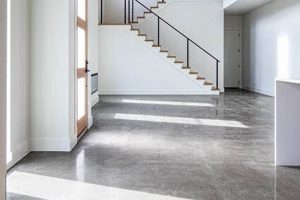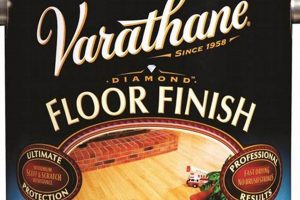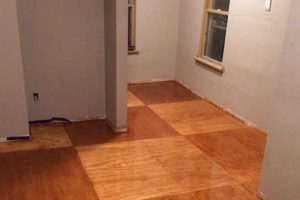A protective coating applied to hardwood flooring, it serves to shield the wood from wear, moisture, and staining. This layer enhances the wood’s natural beauty while simultaneously increasing its lifespan. Examples include polyurethane, varnish, lacquer, and penetrating oil sealers, each offering varying levels of durability and aesthetic qualities. The choice depends on the desired sheen, the expected traffic level, and the type of wood being protected.
Its importance stems from its ability to preserve the integrity of the flooring investment. By safeguarding against daily use, spills, and environmental factors, it reduces the need for frequent repairs or replacements. Historically, natural oils and waxes were employed, but modern formulations offer superior protection and longevity. The benefits extend beyond mere preservation; they contribute to improved hygiene by creating a smoother, more easily cleaned surface, and can significantly impact the overall aesthetic appeal of a space.
Understanding the different types of protective coatings available is crucial for selecting the most appropriate option. Factors such as durability, application methods, and environmental impact should be carefully considered. The following sections will delve into the specific characteristics of common types, explore the application process, and address maintenance strategies to ensure lasting performance.
Tips for Selecting and Maintaining Protective Wood Floor Coatings
This section offers essential advice for achieving optimal results when dealing with protective wood floor coatings. Consider these points to ensure longevity and beauty of the hardwood surface.
Tip 1: Select the Appropriate Type: Carefully assess the area’s traffic level and expected use before choosing a specific type. Polyurethane is suitable for high-traffic areas due to its durability, while oil-based products may be preferred for their natural appearance and ease of repair.
Tip 2: Prepare the Surface Thoroughly: Proper surface preparation is paramount. Sanding the wood smooth and removing all dust and debris is essential for optimal adhesion and a uniform application.
Tip 3: Apply Thin, Even Coats: Multiple thin coats are generally preferable to a single thick coat. This minimizes the risk of drips, runs, and uneven drying, resulting in a smoother, more durable surface.
Tip 4: Allow Adequate Drying Time: Adhere strictly to the manufacturer’s recommended drying times between coats and before allowing foot traffic. Rushing the process can compromise the integrity and appearance of the coating.
Tip 5: Maintain Consistent Environmental Conditions: Optimal temperature and humidity levels are critical for proper drying and curing. Avoid applying the product in extremely humid or cold conditions.
Tip 6: Use Appropriate Application Tools: Choose the right applicators for the chosen product. For example, use a high-quality brush for oil-based products and a microfiber pad for water-based polyurethanes.
Tip 7: Implement a Regular Cleaning Schedule: Routine cleaning with appropriate cleaning products is essential. Avoid using harsh chemicals or abrasive cleaners that can damage the coating.
These tips provide a foundation for achieving a durable, aesthetically pleasing surface. Attention to detail and adherence to best practices are essential for optimal results.
The following sections will explore specific application techniques and troubleshooting advice for common issues.
1. Durability
The durability of a hardwood floor finish is directly proportional to its ability to withstand daily wear and tear, impacting its lifespan and aesthetic appeal. The selection of a coating with inadequate durability for a given environment will inevitably lead to premature wear, scratching, and eventual failure of the finish, necessitating costly repairs or replacement. For instance, a polyurethane finish, known for its robust protection against abrasion and moisture, would be a more suitable choice for high-traffic areas, like hallways or kitchens, than a softer wax finish which is aesthetically pleasing, but lacks the protective qualities required for heavy use.
The level of durability required also depends on the species of wood being finished. Softer woods, such as pine, are more susceptible to dents and scratches, and therefore benefit from a finish that provides a harder, more resilient protective layer. The composition of the coating itself plays a crucial role; finishes with higher solids content generally offer increased durability due to the greater amount of protective material deposited on the surface. Proper application techniques, including thorough surface preparation and the application of multiple coats, also significantly contribute to the overall durability of the protective coating. Any missteps in the application process is also a factor durability.
Ultimately, understanding the relationship between durability and protective coatings is essential for preserving the value and appearance of hardwood flooring. Ignoring this critical aspect can result in diminished performance, increased maintenance requirements, and a significantly shortened lifespan of the flooring investment. Selecting an appropriate coating requires careful consideration of the intended use of the space, the properties of the wood species, and the desired aesthetic outcome. Regular maintenance, including proper cleaning practices, also plays a crucial role in maximizing the durability and longevity of the chosen coating.
2. Sheen Level
Sheen level, a crucial attribute of hardwood floor finish, directly influences the aesthetic appearance and perceived cleanliness of a space. It refers to the amount of light reflected from the surface of the finish, ranging from matte (minimal reflection) to high-gloss (maximum reflection). The selection of a particular sheen level is not merely an aesthetic choice; it affects how light interacts with the flooring, impacting the perceived color, texture, and even the apparent size of the room. For instance, a matte finish, with its low reflectivity, tends to conceal imperfections and scratches more effectively than a high-gloss finish. In contrast, a high-gloss finish can enhance the brightness and feeling of spaciousness in a room but requires meticulous maintenance to avoid showing every speck of dust and blemish.
The choice of sheen level is also intimately tied to the style and intended use of the space. Traditional or rustic interiors often benefit from the subtle, understated elegance of matte or satin finishes, which complement natural wood tones and textures. Contemporary designs, on the other hand, might incorporate semi-gloss or gloss finishes to create a sleek, modern look. Practical considerations also play a role; high-traffic areas may warrant a lower sheen level to minimize the visibility of wear patterns. The application process of the finish can also influence the final sheen level. Uneven application or improper curing can result in variations in sheen across the floor, detracting from its overall appearance. Furthermore, the chosen wood species can interact with the finish to alter its perceived sheen; a darker wood may appear more matte than a lighter wood with the same finish application.
In summary, the sheen level is an integral component of hardwood floor finish, impacting both the aesthetic qualities and practical considerations of flooring. Understanding the relationship between sheen level, lighting, usage patterns, and wood species is essential for achieving the desired look and performance. While a matter of personal preference, choosing the appropriate sheen level ensures the longevity and desired look for the surface.
3. Application Method
The application method employed in applying a hardwood floor finish is paramount in determining the final quality, durability, and aesthetic appeal of the floor. Variations in technique and equipment can significantly impact the coating’s uniformity, adhesion, and overall performance. Careful attention to detail during this process is essential for achieving optimal results and maximizing the longevity of the flooring investment.
- Surface Preparation Impact
The quality of surface preparation directly impacts the adhesion and uniformity of the finish. Improper sanding, inadequate dust removal, or the presence of contaminants can prevent the finish from properly bonding with the wood, leading to premature failure, peeling, or an uneven appearance. A smooth, clean, and properly prepared surface is the foundation for a successful application.
- Application Tools Influence
The choice of application tools, such as brushes, rollers, or sprayers, significantly affects the finish’s texture and uniformity. Brushes may leave brush marks, rollers can create a stippled effect, and sprayers offer the potential for a smooth, even coat. Each tool requires specific techniques and adjustments to achieve the desired outcome. Using the wrong tool can result in an uneven, unprofessional looking finish.
- Environmental Factors Effect
Ambient temperature and humidity levels during application can influence the drying time, curing process, and overall quality of the finish. Extreme temperatures or high humidity can lead to uneven drying, bubbling, or other defects. Maintaining optimal environmental conditions is crucial for ensuring a proper curing process and a durable, long-lasting finish.
- Layering and Curing Protocols
The number of coats applied and adherence to proper curing times between coats directly impacts the finish’s durability and appearance. Applying too few coats may compromise the protective qualities, while applying too many can lead to cracking or peeling. Failing to allow adequate curing time can result in a soft, easily damaged finish. Following the manufacturer’s guidelines for layering and curing is essential for achieving optimal performance.
In conclusion, the method of application represents a critical element in the hardwood floor finishing process. From surface preparation to the selection of appropriate tools and adherence to environmental controls and curing protocols, each facet contributes significantly to the ultimate success or failure of the project. Mastery of these techniques ensures a durable, aesthetically pleasing, and long-lasting protective layer.
4. Maintenance Needs
The relationship between maintenance needs and the chosen hardwood floor finish is a critical consideration for ensuring longevity and preserving aesthetic qualities. Different types of protective coatings necessitate varying levels of upkeep, directly influencing the frequency and intensity of cleaning and reapplication procedures. The selection of a coating without considering its maintenance requirements can lead to accelerated wear, damage, and ultimately, a premature and costly replacement of the flooring. For example, a floor coated with a wax finish, while offering a natural appearance, demands regular waxing and buffing to maintain its protective properties and sheen. Conversely, a polyurethane finish, known for its durability, requires less frequent maintenance, primarily consisting of routine sweeping and occasional damp mopping with a pH-neutral cleaner. Failure to adhere to the prescribed maintenance schedule for each respective coating can result in diminished performance and an undesirable appearance.
Understanding the specific maintenance needs associated with different hardwood floor finishes is essential for informed decision-making. Penetrating oil finishes, for instance, may require periodic re-oiling to replenish the protective layer and prevent the wood from drying out. Surface finishes, such as polyurethane, generally necessitate less frequent reapplication but may be more susceptible to scratching and require careful selection of cleaning products to avoid damaging the coating. The environment in which the flooring is installed also plays a significant role in determining maintenance needs. High-traffic areas, homes with pets, or environments prone to moisture exposure will necessitate more frequent cleaning and maintenance to mitigate the effects of wear and tear. Furthermore, understanding maintenance protocols also has financial significance. A less expensive finish may require more frequent and costly maintenance procedures than a more expensive, but easier-to-maintain, product. Therefore, a life-cycle cost analysis is often warranted when selecting a protective coating.
In conclusion, the interconnection between maintenance needs and the choice of hardwood floor finish is undeniable. Effective maintenance protocols are essential for preserving the integrity, appearance, and longevity of the flooring investment. By considering the specific maintenance requirements associated with different coatings, understanding the environmental factors that influence upkeep, and adhering to recommended cleaning practices, homeowners can ensure the enduring beauty and value of their hardwood floors. Ignoring this critical relationship can result in premature degradation, increased maintenance expenses, and ultimately, the need for costly repairs or replacements.
5. Wood Compatibility
Wood compatibility represents a critical determinant in the success of any hardwood floor finishing project. The inherent properties of different wood species interact uniquely with various finish types, influencing adhesion, color, drying time, and overall durability. Ignoring these interactions can lead to a range of problems, from finish failure and discoloration to compromised structural integrity.
- Tannin Content and Finish Reaction
The presence of tannins, naturally occurring compounds in certain wood species like oak and walnut, can react adversely with some finishes, particularly oil-based products. This interaction, known as tannin bleed or tannin pull, results in discoloration, staining, or streaking of the finish. Selecting a compatible finish, such as a water-based product or a finish specifically formulated to resist tannin bleed, is crucial for these species.
- Wood Porosity and Finish Absorption
The porosity of wood influences the absorption rate of the finish. Open-grained woods, such as ash and red oak, tend to absorb more finish than closed-grained woods like maple or birch. This differential absorption can lead to uneven sheen levels and require additional coats to achieve a uniform appearance. Using a sanding sealer can help to regulate absorption and ensure a consistent finish.
- Moisture Content and Finish Adhesion
The moisture content of the wood at the time of finishing significantly impacts adhesion. Wood that is too damp can prevent the finish from properly bonding, leading to peeling, cracking, or blistering. Ensuring that the wood has acclimated to the environment and has a stable moisture content is essential for a durable and long-lasting finish.
- Wood Hardness and Finish Durability
The hardness of the wood affects the durability of the finish. Softer woods, like pine or fir, are more prone to dents and scratches and require a more durable finish, such as polyurethane, to provide adequate protection. Harder woods, such as Brazilian cherry or hickory, can tolerate a wider range of finishes, including oil-based products and waxes.
Ultimately, understanding the interplay between wood properties and finish characteristics is paramount for achieving a successful and long-lasting hardwood floor finishing project. Selecting a compatible finish based on wood species, porosity, moisture content, and hardness ensures optimal adhesion, durability, and aesthetic appeal. Ignoring wood compatibility can result in costly repairs, premature finish failure, and a compromised overall appearance.
Frequently Asked Questions about Hardwood Floors Finish
The following addresses common inquiries regarding the application, maintenance, and selection of appropriate protective coatings for wood floors.
Question 1: What are the primary factors determining the lifespan of a hardwood floor finish?
The lifespan depends on several variables: the type of finish applied, the amount of foot traffic the floor endures, the quality of maintenance performed, and environmental conditions. High-traffic areas necessitate more durable coatings and frequent maintenance schedules to prevent premature wear.
Question 2: How often should hardwood floors be refinished?
The frequency of refinishing is contingent upon the thickness of the existing finish and the level of wear it sustains. Typically, hardwood floors may require refinishing every 7-10 years in residential settings, but more frequent refinishing may be necessary in commercial spaces or households with pets or children.
Question 3: What are the key differences between oil-based and water-based hardwood floor finishes?
Oil-based finishes offer greater durability and a richer amber hue, but emit higher levels of volatile organic compounds (VOCs) and require longer drying times. Water-based finishes are lower in VOCs, dry faster, and maintain the wood’s natural color, but may not be as durable as their oil-based counterparts.
Question 4: Is it possible to apply a new finish over an existing one without sanding?
In some cases, a refresher coat can be applied to revitalize an existing finish without complete sanding. However, this is only suitable if the original finish is in good condition, free of significant scratches or damage, and compatible with the new coating. Thorough cleaning and preparation are essential for proper adhesion.
Question 5: What cleaning products should be avoided on hardwood floors with a protective coating?
Avoid using abrasive cleaners, harsh chemicals, ammonia-based products, or vinegar, as these can damage or dull the finish. Use pH-neutral cleaners specifically designed for hardwood floors and follow the manufacturer’s instructions.
Question 6: What are the most effective methods for preventing scratches on hardwood floors?
Preventative measures include using rugs in high-traffic areas, placing felt pads under furniture legs, trimming pets’ nails, and avoiding wearing shoes with hard soles indoors. Regular sweeping or vacuuming removes debris that can scratch the finish.
Selecting the appropriate protective coating and adhering to proper maintenance practices ensures the enduring beauty and value of wood floors.
The following section will explore specific troubleshooting scenarios related to hardwood floor finishes.
Concluding Remarks on Hardwood Floors Finish
The preceding sections have detailed the multifaceted aspects of hardwood floors finish, from selection and application to maintenance and wood compatibility. The analysis underscores its critical role in preserving the structural integrity and aesthetic appeal of wood flooring. A comprehensive understanding of the finish’s durability, sheen level, application method, maintenance needs, and interaction with different wood species is essential for informed decision-making.
Properly selected and maintained, the protective coating provides long-term value and enhances the beauty of the flooring. Continued research and development in coating technology promise further advancements in durability, environmental friendliness, and ease of application. Therefore, staying informed about evolving techniques is critical for homeowners and professionals alike. The key is to adopt a proactive and knowledgeable approach.







